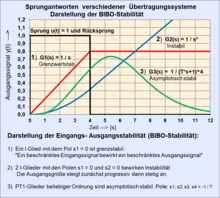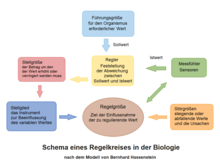Control system
A control loop is the dynamic action sequence between controller and controlled system for influencing the controlled variable 
An important factor here is the negative feedback of the current value of the controlled variable to the controller 
It is the task of the controller to determine the time response of the controlled variable with regard to its dynamic behavior according to specified requirements. More complex control loop structures may be required to meet conflicting requirements such as good command and disturbance behavior.
For the design of a control loop with a controller, the mathematical model of the controlled system is required. For limited, nonlinear and dead-time systems, the use of numerical calculation is recommended. The classical graphical controller design methods (Bode diagram, locus of frequency response, root locus method) have only a didactic informative meaning.
A stable control loop can become unstable when parameters are changed, even if the individual components of the control loop are stable in themselves. On the other hand, a control loop with an optimized controller can also behave stably if a single control loop element is unstable.
Control loops can be found in many fields besides engineering: Biology, ecology, economics, quality management, corporate structures, linguistics and others.


Example of the representation of stability for different dynamic systems
Control loops outside the technology
Biological control circuits
The term "control loop" is used in biology to describe processes in living organisms for the maintenance of homeostasis. Control loops are therefore not always purely technical models, but a general organisational principle that can also be understood under terms such as self-regulation and systems theory. There are both relatively simple and more complex ones at the physiological level within the organ systems of higher organisms that contribute to their homeostasis through negative feedback, up to the highly complex control loops within communities at the level of ecology. Examples:
- End product inhibition of enzyme activity in cells and tissues.
- Regulation of the water balance in plants
- Regulation of respiration (a humoral control circuit based on chemoreceptors)
- Regulation of the oxygen content of the blood
- Thermoregulation: Animals at the same temperature require a certain body temperature for survival, which varies within a tolerance band, but should not leave this band. The nervous system of every animal of the same temperature therefore contains a temperature control circuit with corresponding receptors as sensors, and blood vessels that can dilate and constrict, as well as muscles as regulators, in humans also variable transpiration.
- Regulation of the water balance and the acid-base balance by the kidney
- Pulse regulation: For the adequate supply of the cells with oxygen and energy, sufficient blood circulation is required, which depends on the physical load. This is ensured, among other things, by the regulation of the heart rate and the cardiac output by the autonomic nervous system.
- Blood pressure regulation: If the blood pressure is too low, sufficient blood circulation and supply of the cells with oxygen and energy is not possible. Too high blood pressure damages the organs. Therefore, there is a blood pressure regulation in animals and humans.
- Regulation of the amount of light entering the eye by enlarging or reducing the pupil and the adaptation of other sensory organs (Weber-Fechner law).
- Regulation of the blood level of numerous hormones (e.g. in the thyrotropic control circuit)
- Regulation of food intake through hunger and satiety
- Regulation of the blood sugar level: The blood sugar ensures the energy supply of the organism and is adapted to the physical strain.
- Regulation of population density through predator-prey relationships
- There is also a control loop in species protection; the target value here is the favourable conservation status of populations.
See also: Biological cybernetics
Economic control loops
From the field of economics, the following should be mentioned:
- market pricing
- Market regulation of the state.
- spider web theorem, pig cycle
Management-oriented control loops
- management cycle
- Control loop of personnel management
Quality Circle
In the area of quality management, there is the quality circle, on which quality management systems are based in accordance with the DIN EN ISO 9001:2015 regulations.
Linguistic control circuits
In the article Linguistic Synergetics it is shown that Quantitative Linguistics has developed control circuits on different language levels (morphology(linguistics), writing, syntax and others), which partly also act beyond the language levels or connect them with each other.

Scheme of a control loop according to Bernhard Hassenstein
Control loops in technology
Introduction
A real control loop consists of several individual components of the controlled system and the controller, each of which has a specific time response. While the controlled system is usually available as a technical system, a system analysis of the controlled system is required for the mathematical treatment of the closed loop, from which a mathematical model can be determined. The model should largely correspond to the time response of the real controlled system. The observation of a signal course at a transmission system for a given input signal 



In conjunction with the controlled system model 


Modern electronics allow the realization of arbitrarily complex controller structures with justifiable economic expenditure. In many cases, digital controllers are used instead of analog controllers and may be combined with digital measuring and control elements. The digital signals are value and time discrete signals. These control loops behave like analog control loops if the resolution and sampling rate are high enough.
For the design of a controller in engineering, the mathematical model of the controlled system is required. For multivariable systems (MIMO) the controller design with the state space representation is suitable, for nonlinear and dead-time single-variable systems (SISO) the numerical calculation is recommended. The classical graphical controller design methods (Bode diagram, locus of frequency response, root locus method) have only didactic informative significance.
The most common mathematical system descriptions are the differential equation 


![{\displaystyle y(k)=y(k-1)+f\,[u(k),\,System]}](https://www.alegsaonline.com/image/140a5613af62de04238f567f08aca7501f19c124.svg)
The aim of the mathematical descriptions of control loop elements is the calculation of the dynamic input and output behaviour of individual components, closed control loops and their stability.
Due to required quality criteria (control quality) of the transient process of the controlled variable, the heuristic method "trial and error" is usually used in the offline simulation of the control loop.
Simulation of the input and output behaviour of a control loop
Unfortunately, individual components of most technical controlled systems behave non-linearly. The transfer function and its algebraic calculation may only be used for linear transfer systems.
If, for example, the controlled system contains a dead time (transport time), limiting effects of some components or other non-linearities, the discrete-time calculation of the control loop with difference equations is practically the only option for the system calculation. The open control loop is closed by the relation 
Difference equations or a chain of difference equations describing several elementary systems connected in series let the output quantity 


The typical form of a recursive difference equation of common control loop elements (linear factors) is:
![{\displaystyle y(k)=y(k-1)\,+f\,[u(k),\,\Delta t,\,T]}](https://www.alegsaonline.com/image/7a3357e7cf11cec7727fc8d5e524aee4843d76e3.svg)
Where 

Difference equations of the linear time-dependent system components can be derived from ordinary differential equations by replacing the differential quotients by difference quotients Δ . 

Digital controllers
Digital control means that the input signal of a dynamic system or a subsystem is sampled at specific discrete points in time, calculated synchronously in time and output as a digital output signal. Other terms refer to this process as "discrete-time control" or also as "sampling control".
Digital controllers are implemented by microcomputers. They process difference equations suitable for the desired control behavior of the overall system.
Since the controlled systems are mostly given analog systems, the interface of the system requires an analog input signal via a DA converter.
Advantages: One-time hardware development effort, easy parametric system changes via software, realization of more complex controller structures, multitasking.
Disadvantages: The use of a digital controller is only worthwhile for larger production quantities due to the increased technical effort.


Block diagram of a simple standard control loop consisting of the controlled system, the controller and a negative feedback of the controlled variable y (also actual value). The controlled variable y is compared to the reference variable (set point) w. The system deviation e = w - y is fed to the controller, which uses it to form a manipulated variable u according to the desired dynamics of the control loop. The disturbance variable d usually affects the output of the controlled system, but it can also influence different parts of the controlled system.
Search within the encyclopedia
